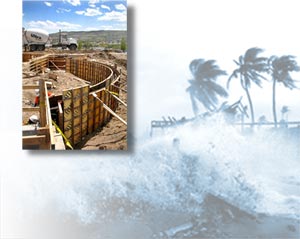ThemesAvailability & Affordability
In 2005, we prepared a special report focusing on this topic.
- Mills, E., R.J. Roth Jr., and E. Lecomte. 2006. "Availability and Affordability of Insurance Under Climate Change: A Growing Challenge for the U.S." Journal of Insurance Regulation, Winter 2006, Vol. 25, Issue No. 2, pp. 109-149. [PDF]
- Also published in report form by Ceres (2005). [PDF]
The following information updates that material:

The insurance sector finds itself on the front lines of climate change, and the response of insurers to this challenge has varied enormously. The reaction of many insurers—particularly in the United States—has been to focus on financial means for limiting their exposure to high-risk areas along the coastlines (Environmental Defense 2007). The Independent Insurance Agents & Brokers of America found that nearly 3.0 million U.S. households lost their homeowners coverage between 2003 and mid-2007, only half of which stated that they were able to find new coverage (IIABA 2007).
Allstate, for instance, has said that climate change has prompted it to cancel or not renew policies in many Gulf Coast states, with recent hurricanes wiping out all of the profits it had garnered in 75 years of selling homeowners insurance (Conley 2007). The company has cut the number of homeowners' policies in Florida from 1.2 million to 400,000 with an ultimate target of no more than 100,000. The company has curtailed activity in nearly a dozen other states. In 2008, State Farm—Florida's largest private insurer—stopped writing new policies in the state (Garcia and Benn 2008). This was after suspending sales of new commercial and homeowners policies in Mississippi the year before (Tuckey 2007). A few months later, after being denied a 47% average rate increase, State Farm announced a complete pull-out, (Hays 2009). About 1.2 million customers will be affected. The Florida Insurance Commissioner referred to the decision as "unnecessary destabilization of the insurance market" (Hays 2009). The editor of trade magazine published an editorial about the problem entitled "Like a Bad Neighbor?" (Friedman 2009).
Also in 2008, Farmers announced that they would stop writing homeowners policies throughout North Carolina and not renew existing ones. Such decisions are not taken lightly; Farmers will forego $55 million in annual premiums but claims that losses would be twice this amount (Hemenway 2008). These impacts haven't been limited to the Gulf coast. According to one estimate, since 2004 one million policies have been canceled in the Mid-Atlantic and New England area, including 50,000 in the New York Metropolitan region (Nevala-Lee 2008).
Oddly, standardized data on insurance price changes are not systematically collected, forcing reliance on news reports and secondary sources. One study reports the following homeowners insurance price increases in the period 2001-2006 (Environmental Defense 2007):
- Alabama: 42%
- Florida: 77% (Miami Beach: 500%)
- Georgia: 45%
- Louisiana: 65%
- Maryland: 76%
- Mississippi: 63%
- South Carolina: 56.4%
- Texas: 50%
- Virginia: 67%
More difficult to detect than formal withdrawals or headline-catching price spikes is the "hollowing out" of coverage through increased deductibles, reduced limits, and new exclusions.

Availability and affordability continue to erode, even for non-household customers, despite the absence of price regulation for non-household insurance (Dixon et al. 2007; Ruquet 2007). The crisis is exemplified by an account from Rand Corporation, in which a property owner bought $38 million in coverage in 2005 for $250,000. In 2006, after their insurer refused to renew their policy, the customer was able to buy only $5 million in coverage, at a cost of $940,000—a four-fold rise in cost and nearly eight-fold drop in coverage (Dixon et al. 2007). Commercial-industrial customers are also affected. For example, following the major losses of 2004 and 2005, property insurance price spikes in the range of 200% to 300% for offshore energy drove some companies to go without insurance (Parekh 2007). Hurricane Ike brought renewed stress on insurers of offshore energy infrastructure, destroying 60 offshore production platforms and causing more than $1 billion in damage, resulting in less capacity (Phillips 2009). Companies around the United States took steps to assume more risk through increased deductibles, lower limits, or establishing their own "in-house" captive insurers (Roberts 2007).
One of the few countries in the world to have high penetrations of commercial flood insurance—the United Kingdom—is grappling with the possibility that the practice will become unsustainable as the hazards increase and insufficient proactive steps are taken to manage risk:
"Due to the government's plans for floodplain development and the effects of climate change, the UK has reached a tipping point: insurers will no longer be prepared to offer household flooding insurance to people in certain areas unless government commits to putting into practice the lessons learned from summer 2007 and couples their actions with significant investment."
(Institution of Civil Engineers 2008)
Dislocations in the commercial lines markets suggest that there are factors at work beyond oft-critized regulatory obstacles that limit price increases, such as the increased unpredictability that climate change has brought to catastrophic losses projections. In its response to the 2005 Carbon Disclosure Project survey, Bermuda-based ACE Limited has remarked that
"[r]adical changes in natural catastrophe frequency and/or severity could eliminate certain of our markets [sic] through physical damage, price escalation, or regulatory activity... unpredictability could negate the use of actuarial techniques and undermine our ability to price and risk-manage product offerings."
Climate change of course conspires with settlement and land-use planning practices that magnify exposures to catastrophes.
Insurers are recognizing that simply raising prices to keep pace with the impacts of climate change may be an elusive undertaking. Travelers summed up the predicament in its latest (2008) response to the Carbon Disclosure Project survey:
"Our ability to adjust pricing, modify contractual underwriting terms or reduce exposure to the extent necessary to offset the rising costs of catastrophes may be limited due to considerations of public policy, the evolving political environment and/or social responsibilities. A consequence of trying to price this exposure appropriately is reduced consumer demand for property insurance coverage due to the increased cost of obtaining such coverage. Also, the inability to offer catastrophe exposed insurance coverage at affordable rates and at adequate financial returns may discourage our customers from purchasing non-catastrophe exposed insurance coverage from us."
The availability-affordability issue places a bright light on the respective roles of the public sector and insurers. For example, according to the Boston Globe, 150,000 Massachusetts residents and about 40 percent of homeowners on Cape Cod get their homeowners' insurance from the FAIR ("Fair Access to Insurance Requirements") Plan, because they are no longer able to obtain affordable coverage in the private market (Blanton 2008). While the crisis of insurance availability and affordability has deepened, a study from the U.S. Governmental Accountability Office brought into question the ability of government-backed insurance to provide a reliable alternative (USGAO 2007). Questions have since been raised about the capacity of the much-noted public insurance mechanism of last resort in Florida—Florida Hurricane Catastrophe Fund—to withstand major storms (Greenwald 2008). The issue extends well beyond the U.S. borders. As a case in point, after its members suffered a stunning $6 billion in projected insured flooding losses during the summer of 2007 (180,000 claims), the Association of British Insurers called on the U.K. government to step up its investment in flood defenses as a necessary condition for maintaining insurability (ABI 2008c; Wearden 2007). Also in 2007, European windstorm Kyrill inflicted $10 billion in losses on insurers (Felsted 2007).
Restriction of insurance is often criticized, yet, in some cases, it can also be viewed as a recognition of previously hidden costs and an indication of society's limited ability to buy its way out of the effects of climate change.
[top]
